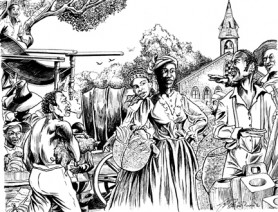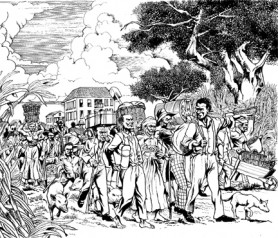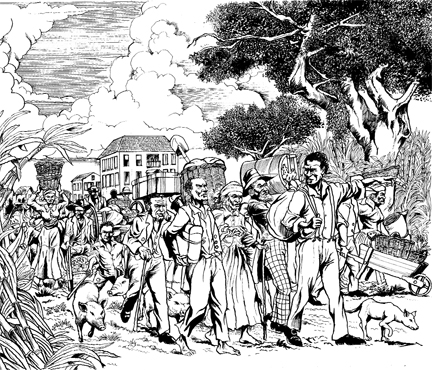By David A. Granger
November 2009 marks the 170th anniversary of the purchase of a single village and the start of a movement that laid the foundation for a nation of human settlements far different from the plantations that existed before.
Even if they had not been immortalised in The Purchase − an inspiring 1980 musical play by William ‘Bill’ Pilgrim − the pioneers who purchased Plantation Northbrook (or Northbroke) would still have been the sort of people of whom legends are made. The purchase on November 7, 1839 launched a movement that transformed a dreary collection of sugar plantations on the coastland of British Guiana into a chain of human settlements from the Corentyne to the Pomeroon Rivers.

For Allan Young, the village movement in British Guiana “embraced more than four times the number of followers that were with William of Normandy on his invasion of England… in 1066” and could be compared with “the great movements of mankind that changed the course of history in early times.” Rawle Farley described the historical phenomenon as “the most spectacular and aggressive land settlement movement in the history of the people of the British Caribbean and a movement which seemed to one planter in British Guiana to be certainly without parallel in the history of the world!”
Given the times, these encomiums were no exaggeration. Although Bill Pilgrim’s play is little remembered today, the legend of Victoria Village − as the Plantation Northbrook was renamed by its purchasers − became an inspiration to future generations. Victoria has been called ‘our first village’ − misleadingly because that title ignores the scores of indigenous hinterland settlements that existed from time immemorial − and its historical relevance to the evolution of local government and the economic landscape of the coastland cannot be disputed.
This month, November, marks the 170th anniversary of the purchase of a single village and the start of a movement that laid the foundation for a nation far different from the plantations that existed before. Eighty-three free men and women drawn from five plantations − Ann’s Grove, Dochfour, Enmore, Hope and Paradise − paid the price of 30,000 guilders (about $10,284) for Northbrook, a former cotton plantation of about 202 hectares (about 500 acres).

It is a matter of legend that two-thirds of the money was paid right away in coins, delivered in a wheelbarrow, some of them still black with the mud in which they had been buried. The remainder was covered by a promissory note which was redeemed three weeks later.
Exodus
The epic began when the enslaved Africans were finally emancipated in 1838 and the European planters tried to prevent them from leaving the plantations. When they did leave, they were obstructed from setting up a viable village which some thought would rival the plantation economy for labour and land. The planters’ reasoning was that labour was already in short supply and, if the freedmen and women worked on their own provision grounds and village farms instead of in the canefields, plantation labour would become even more scarce and costly.
Within days of African Emancipation on August 1, 1838, women, young children and old men began to withdraw from plantation labour. Some able-bodied men combined to form ‘task gangs’ to approach planters to negotiate their wages, work shorter days and spend more time on their own provision grounds. Contrary to popular belief, there was no mass exodus at first.
There was, however, unmasked hostility by planters who deliberately destroyed fruit trees and dug up provision grounds in order to make the freed labourers dependent on plantation wages, rather than their own produce, for their living. The freemen considered this an aggression but it would take 15 months after Emancipation before they started to buy land, leave the plantations and move in their own villages. There were four underlying factors for this movement.
First of all, was the human love of liberty. The Africans rejected the humiliating punishments, inhumane conditions and rigid regime on the plantations. They aspired to the pursuit of their own culture, religion, and social relations − all of which were impossible in the yards of the plantations.
Second was the desire for economic independence. Africans, for generations, had derived their living from the soil. Based on their experience and expertise in agriculture, they felt confident that, like the Europeans, they could embark profitably on large-scale crop cultivation. To do this, they needed their own land on which to live and to work.
Third was the availability of large amounts of land. This became possible owing to the collapse in commodity prices in the London market where there was growing competition from cheaper beet and cane sugar and cotton. Falling prices were depressed further by the creeping introduction of free trade measures which culminated in the Sugar Duties Act of 1846. This precipitated bankruptcy, the abandonment of unprofitable cotton and sugar plantations and the willingness of planters − including some enlightened solvent ones who reasoned that it was a good way to retain free labour − to sell idle land close to the plantations at inflated prices.
Fourth was the availability of specie − coin money that the freemen had carefully hoarded and reserved for the very purpose of buying land. This enabled them, collectively and individually, to purchase many of the properties in hard cash.
Travails
Buying the abandoned plantations was the easy part. Villagers in those days could not have been expected to comprehend the complexity of colonial commerce on which the sugar industry was based and the obligation of the government to protect the planters’ interests. They soon found that good intentions were no guarantee of success. Following their dreams, they encountered a nightmare of provocation from the planters including outright flooding.
A story, probably apocryphal, tells of the Victoria villagers erecting a bell to summon residents in the event of a flood so that, together, they would repair the breached dam. When the planters realised that the villagers could not be intimidated, they spread ghost stories thinking that the superstitious villagers would not come out to repair the dam at night. Aunt Belinda, however, was courageous enough to watch the dam but was found strangled by her own scarf the following morning. She became a martyr and, after that incident, the village was never again flooded by the planters.
So much for legend! The reality was that villagers’ travails persisted for well over 50 years − a period that for convenience could be divided into four phases.
The first phase, which lasted for much of Governor Henry Light’s tenure from 1839 to 1848, marked the ‘rise’ of the villages and was the period of most significant increase in village lands. Over 6,075 hectares [about 15,000 acres] were bought for more than $1,000,000, ‘serious’ money in those days. The village population was augmented markedly in the aftermath of the two ‘general strikes’ in 1842 and 1848 directed against the plantations. By the time of the first in 1842, the population reached 15,906 and, by the second strike in 1848, it nearly trebled to 44,443.
The second phase was one of ‘reaction’ by the planter class and lasted roughly from 1849 to 1861, largely under the governorship of Henry Barkly and Philip Wodehouse. It was at this time that the ‘legislative encirclement’ of the villagers became most acute. The Court of Policy (as the legislature was called) passed various ordinances which aimed to prohibit the joint purchase of land by more than 20 persons, to partition lands, to impose rates on individual holdings and to raise the upset price of crown lands which could be sold only in minimum parcels of 100 acres. The general idea, clearly, was to limit the expansion of the peasantry.
The villagers realised, however, that centralised public works such as drainage installations could be financed and managed only by a centralised authority and taxation. At the request of the ‘big five’ villages of the day – Beterverwagting, Buxton, Friendship, Plaisance and Victoria – the Village Management Bill of 1856 had been drafted to provide for an elementary democratic system through the establishment of village councils which were empowered to construct and maintain village works. Unfortunately, and quite unrelated to the village movement, the disturbances known as the ‘Angel Gabriel Riots’ erupted in February 1856. In its wisdom, the government sought to recover the cost of compensation for the damage done to property by imposing a registration tax. The villagers’ anger at the government was intense and, as a result, the implementation of the measures faltered.
The third phase, from 1862 to 1881, was one of ‘resistance’ by the peasantry. Led by the policies of Governor Francis Hincks, special legislation was introduced to levy ‘improvement rates’ and to put up villagers’ property for sale to recover those rates if they remained unpaid. This, along with other harsh fiscal measures, led to the outbreak of the ‘Great Rates War’ (1863-64), mainly in Buxton-Friendship on the East Coast Demerara, but extending also as far as Ithaca on the West Bank Berbice. Villagers refused to pay rates. There were fears of disorder and armed police and troops had to be deployed. In a celebrated confrontation, the train on the East Coast railway was stopped at Buxton by irate villagers.
The fourth phase, from 1882 to 1887, was one of ‘reform’ largely by Governor Henry Irving. The reforms, however, were of a reactionary character and were aimed at the greater concentration of power in the hands of central government officials and the diminution of local democracy in the villages. Not only had the growth of the villages been halted by 1887, but the villages came under the control of state-appointed commissioners, disease was rampant and the economies were faltering. The result was that village growth was stunted and the subordination of the peasantry to the plantocracy was assured. There would be no rival to sugar monoculture.
Problems
The village movement encountered a plethora of problems from the outset and they persisted, to greater or lesser degree, for the remainder of the 19th century. One of the most pressing was the government’s insistence that the villagers should bear the full costs of local public works, particularly roads, dams and bridges and the perennial problem of sea defence, drainage and irrigation. During the floods that frequently afflicted the low, flat East Demerara and West Berbice coastland, agriculture was not possible unless excess water was removed.
The maintenance of a coastal drainage system required massive capital investment and centralised management, neither of which was available to the villages. According to Alan Adamson, only the four largest villages on the East Coast possessed the resources to acquire the steam-driven, centrifugal pumps which could efficiently drain the empoldered lands by the 1870s. Many of the other villages suffered greatly.
The loss of crops, livestock and food supplies caused malnutrition. Environmental conditions, especially on the East Coast Demerara and West Coast Berbice engendered epidemics of cholera, malaria and yellow fever which spread easily in the prolonged and extensive floods. Together with insufficient food, unsanitary housing and inadequate medical attention, morbidity debilitated the villagers. High levels of mortality actually caused the African-Guianese population – 88,486 in 1831 and 86,451 in 1851 – to decline.
Many ‘communal’ villages were plagued by what Brian Moore described as the “parcellization of land into small plots” in particular and the “chaotic land tenure system” in general. By mid-19th century, most peasants possessed less than an acre of land and could engage only in subsistence micro-culture. Worse, out of a mistaken sense of fairness to ensure that no villager received “better” land than another, a single person might be given three or four holdings – including, for example, a swamp and a bush lot, in different parts of the village away from his house. This fragmentation was inefficient in the extreme.
As the original title-holders of un-partitioned properties died, confusion arose about ownership especially when complicated by intestacies, insolvencies, sales and bequests. As time went by, the number of shareholders in ‘communal’ villages tended to increase from one or two dozen to one or two thousand. The prevalent Roman-Dutch land law, which provided for the inheritance of undivided shares of the property by widows and children further complicated the problem of title.
Villagers were also impoverished by the unbearable burden of taxation with which they were encumbered. Fees for the use of canoes, carts, mules and for employment as hucksters or porters were increased markedly. At another level, duties on imported goods known to be used mainly by villagers were raised. High rates were imposed on villages and land taxes were increased. The combination of fees, dues, duties, rates and taxes was a constant drain on the meagre cash reserves of the villagers. Improvements had to be curtailed, inhibiting expansion and making the accumulation of savings impossible.
These factors contributed to the premature economic exhaustion of the villages. The initial purchasing of abandoned estates at exorbitant rates, heavy expenditure to meet the demands of empoldered agriculture and the destruction caused by eroded front dams, broken backdams, blocked kokers and silted canals, combined to paralyse the economy of the peasantry.
Finally, the planter class ensconced in the Court of Policy completed what Adamson calls “legislative encirclement” of the peasantry with a series of prejudicial laws. A web of ordinances prevented Africans from combining in large numbers, prescribed the partition of collectively-acquired lands, imposed rates, raised prices and usurped the authority of village administration by appointees of the Court of Policy.
Idealism
The African Village movement started by the purchase of Victoria Village was an idealistic attempt to transform legal Emancipation into economic reality. In so doing, however, villagers came to be perceived by the planters and officials as competitors with the plantations for the scarce resources of the colony, particularly labour, land and official funds. The antagonists – the African peasantry on the one hand and the European planter class on the other – were locked in mortal combat for over half century. In the end, it could be said that the plantation, supported by state-funded migrant labour, flourished while the villages, bereft of capital, management and markets, languished.
In the final analysis, nevertheless, the beginning of free village life was a catalyst for the infrastructural development of rural areas. The construction of homes, churches, schools, burial grounds, bridges and roads changed the pattern of rural settlement. Village administration called into existence a mode of organisation and a body of ordinances which became the public school-house where many national politicians had their apprenticeship.
The movement, in particular, modified the plantation economy by diversifying agricultural production, expanding the domestic market and attempting a communal approach to land administration. Not least of all, the clash between European planters and the African peasants accelerated the process of Madeiran and Asian immigration.
The difficulties which the village movement had to confront did not diminish its historical significance. In broad terms, the organised and orderly manner in which thousands of indigent freemen attempted to construct an entirely free society and independent economy and actually succeeded in buying and building millions of dollars worth of land and property so soon after emancipation, was a unique historical achievement.

